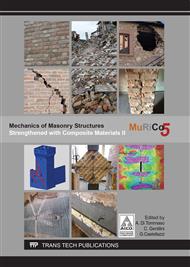p.448
p.456
p.465
p.472
p.480
p.488
p.496
p.504
p.512
Grouts with Improved Durability for Masonry Consolidation: An Experimental Study with Non-Standard Specimens
Abstract:
Multi-leaf stone masonry walls are among the most vulnerable elements of historic constructions. Grout injection is a common and efficient technique to consolidate such masonries. It consists of introducing a grout into the masonry inner core in order to upgrading the cohesion of the wall by ensuring the transversal bond between the external leaves and improving its monolithic behaviour. Notwithstanding, the recrystallization of salts due to changes in moisture content causes several damages in these masonries, even after the consolidation intervention. This paper aims to assess the potential use of linseed oil in natural hydraulic lime-based grouts to mitigate the water penetration and therefore the damages from salts crystallization. Linseed oil was used in former times as an additive for mortars in order to grant hydrophobicity. In this study several properties of the grouts were evaluated: rheology, mechanical strength, water absorption, adhesion and durability assessed by testing the resistance to sodium chloride. Moreover, this paper also analyses the correlation between non-standard specimens (with reduced size) and standard specimens (40x40x160 mm3). The experimental results revealed that the grouts durability and water transport are significantly improved with added linseed oil. It was also possible to observe a small reduction in mechanical resistance with the presence of linseed oil; however, acceptable strength values to promote an appropriate consolidation were ensured. Furthermore, the reduced size specimens revealed to be a viable alternative to the standard ones.
Info:
Periodical:
Pages:
480-487
Citation:
Online since:
July 2017
Keywords:
Price:
Сopyright:
© 2017 Trans Tech Publications Ltd. All Rights Reserved
Share:
Citation:


